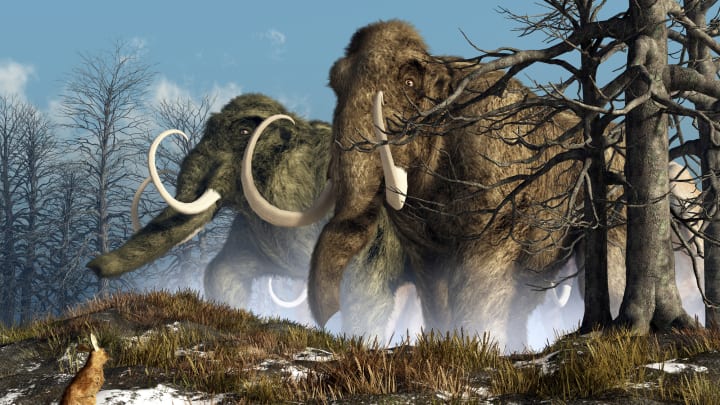How Mammoth Poop Is Changing What We Know About Their Extinction

When did woolly mammoths go extinct? Their fossilized bones say one thing, but their poop paints a messier picture.
A growing craze in the ecology world involves using DNA left in the environment, called eDNA, to learn about ancient ecosystems. A major study in 2022 analyzed eDNA and revolutionized our picture of prehistoric Greenland. But some scientists argue that decoding the past with left-behind DNA may not be as precise as researchers hope.
In a much-publicized paper in the journal Nature, scientists claimed that mammoths survived in North America and Eurasia much later than previously thought, based on remnants of their poop left behind in ancient soil. But two fossil experts are butting heads with these researchers over their new way of uncovering the past. The conflict may reveal new insight to the impacts of climate change and humans on animal populations, from the prehistoric world to today.
Dead or Alive?
The poop we flush each day carries unique information, including our DNA, and animals similarly “dump” DNA into their environment throughout their lives. Scientists have recently begun using this eDNA to study ancient animals, since it’s easier to find than actual fossils: We poop every day, but we only leave behind one set of bones.
But the new approach raised eyebrows among traditional fossil scientists when researchers found mammoth DNA in 4000-year-old sediment from a peninsula in northern Siberia, even though the vast majority of mammoths (with the exception of a few tiny island populations) were thought to have died out 10,000 years ago. This claim would mean mammoths were walking the Russian tundra long after the Great Pyramid in Egypt was completed.
Doubting the explosive result, Joshua Miller of the University of Cincinnati and Carl Simpson of the University of Colorado decided to publish their concerns in Nature. “This paper really extended the ‘youthfulness’ of mammoths,” Miller tells Mental Floss. “It seemed like a great test case to explore an alternative hypothesis for how one might interpret these data.”
Their “alternative hypothesis”: The eDNA came from the frozen remains of much older mammoths, rather than their still-living descendants. Miller and Simpson show that in the frigid arctic environment, animal bones can stick around for thousands of years before decaying and releasing DNA into the soil. They say it’s impossible to tell whether the 4000-year-old eDNA came from the poop of a living mammoth or the slow decay of an already long-dead corpse.
In fact, Miller argues, if mammoths died out so recently, their carcasses would still be sitting on the arctic tundra to this day. “If you say that’s when the last animal died, given how cold it is at that location, we would expect that the bones of those last populations would still be recoverable out there,” he says. Yet no such remains have been found.
Yucheng Wang, lead author of the original paper, isn’t surprised that the method has its skeptics. “For fossils, you have a bone,” Wang tells Mental Floss, “but with DNA, you don’t have anything to show people. It’s all data.”
Still, Wang is convinced that his data came from real living mammoths.
In a reply published alongside Miller and Simpson’s comments, he and his colleagues defend their findings. They agree that most mammoths died 10,000 years ago when the Arctic got much warmer. But they argue that a tiny group of hardy holdouts lasted much longer, leaving behind tons of DNA-packed mammoth pies, but too few bones to find. “The population size is so small compared to the previous one,” Wang says, “so it’s extremely unlikely to find and date the latest survivors.”
But Miller maintains that mammoths are too conspicuous to live for so long without leaving behind any fossils. A population small enough to leave no trace but poop, he says, could never survive for several millennia.
Waning Numbers in a Warming World
If the later extinction date turns out to be true, it would mean that mammoths and humans coexisted for thousands of years, putting a huge dent in the theory that we hunted them to extinction. And with today’s large mammals facing similar threats from both humans and a changing climate, this question is as important as ever. “We really have to, as a community, understand the underlying truth of when mammoths went extinct,” Miller says. “The fossil record is a great tutorial to understand what happens when things go extinct, which is really important for understanding how to manage ecosystems today.”
Wang is encouraged by the lively conversation surrounding their results: “It's good to publish this kind of discussion into a high-profile journal, so that people from other fields can also pay attention.”
Miller points out that the growing importance of eDNA research makes the debate especially timely. “This lab and others are really pushing the envelope,” he says. “I think the exchange is really great and really important to have, and I’m really glad it’s happening now.”